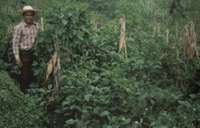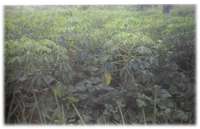The Advantages of Jack Beans

This photo shows a whole series of seeds that are in the “Canavalia” genus, meaning they are closely related to the jack bean (Canavalia ensiformis). Any of these seeds could be used instead of the jack bean, but only the white-seeded jack bean (top row center) and the red “sword bean” next to it can be found outside of Mali, as far as I know. The white seeds of the jack bean are about 2 cm long, a good deal larger than they appear here, and the pods of the jack bean are normally almost 30 cm long.
The main reason we use jack beans are their amazing ability to grow well on highly degraded soils and during very bad droughts. For instance, in Nampula Province in northern Mozambique, the soils are so degraded that the farmers reluctantly gave up growing maize over 20 years ago, and virtually the only basic food crop farmers can grow now is cassava. Nevertheless, some farmers there who intercropped jack beans with their cassava for just one year not only could produce maize the following year, but harvested about the same 1 t/ha of maize that they had been harvesting 30 years before. That is, in one year, the jack bean had undone about 30 years of soil degradation.

Mexico. Only a few maize plants in this field survived a serious drought, but the jack beans look like they were irrigated yesterday. The jack bean is the most drought-resistant of all the known species of green manure/cover crops presently being used around the world.
Jack beans are also capable of fixing tremendous amounts of nitrogen--up to a maximum of 240 kg/ha of nitrogen, equal to the nitrogen in some ten bags of urea, the chemical fertilizer with the highest amount of nitrogen (although the amount of nitrogen the jack bean will produce on a degraded soil will be a lot less). No crop raised by smallholder farmers in Africa would ever need anywhere near that amount of nitrogen at one time. Jack beans are also tremendously resistant to insect pests. In Kenya, where serious attacks of locusts have destroyed every crop in people’s fields, the locusts did not damage the jack beans at all!
Mexico. Only a few maize plants in this field survived a serious drought, but the jack beans look like they were irrigated yesterday. The jack bean is the most drought-resistant of all the known species of green manure/cover crops presently being used around the world.
In spite of all these advantages, once jack beans have made a soil moderately fertile, they have nowhere near all the advantages that lablab beans, pigeon peas, and many other gm/ccs have, because jack beans contain several poisons. They can only be consumed safely by humans after several days of cooking and soaking the seeds. Therefore, we only use jack beans for one or two years, even on highly degraded soils and where droughts are common. After that, the soils will have improved enough both in fertility and drought resistance that we can switch to lablab beans or pigeon peas, so we can produce a good deal of healthy, high-protein food at the same time that we continue improving the soils’ fertility and drought resistance.
Managing Jack Beans to Achieve Maximum Benefits
If one’s soils can produce about 1 t/ha of maize or more during a year of good rainfall without the use of synthetic fertilizer, one can start right off with lablab beans or pigeon peas, and never bother with jack beans. On the other hand, if a field produces less than about 800 kg/ha of maize, or a farmer has already switched to sorghum, millet, or cassava because of the droughts, then one should start using gm/ccs by planting jack beans. Even if you would like to restore a piece of wasteland (that is, land that produces absolutely nothing of value), you can easily do this with jack beans as long as the soil is not too acidic (it should have a pH of more than 4.5). This level of acidity is quite rare in drought-prone areas, except where synthetic fertilizer has been used on a field for many, many years). Before planting the jack bean on a wasteland, one must kill the vegetation growing on it before planting the jack beans.
Frankly, the most difficult problem with using jack beans is obtaining the seed where it does not already exist. Jack bean seed does exist in parts of Mali, Burkina Faso, Kenya, and southern Malawi. If no one in your area has seed, and you have a good postal service, you can easily order a small packet of seed from the ECHO office in Arusha, Tanzania, in order to multiply it for your own use or that of others. If not, it is quite possible that you can find seed in the forest near your home. Show any village women the photo above of jack bean seeds and their pods, and they will be able to tell you if such a plant exists in your nearby forest, and where.
The best jack beans to use are the bushy kind, because they will not climb your crops and perhaps pull them down. This bushy type is what ECHO distributes. However, the jack beans in African forests are almost always of the climbing kind. This means that when it is intercropped with maize, sorghum or millet, it will have to be cut back to a height of about 25 cm just as soon as it begins to pull over the stalks of the maize, sorghum or millet. This, of course, will require extra work during the growing season, but will help fertilize the soil and will only have to be done for one or two years, at which point you can switch to the lablab beans or pigeon peas.
The jack bean can be planted right along with maize, at the same time. Four seeds/sq mt are about the best density, both for fertilizing the soil and for controlling weeds. Planted this way, the jack bean will end the need to do a second weeding of the maize field, at least during the second year when the soil has improved somewhat.
The jack bean plant should not be killed right after the harvest, but should always be left to keep on growing clear through the entire dry season. It will fertilize the maize or other crops best if it is allowed to keep on growing until just a couple of weeks or a month before the next season’s maize is planted.
If there is a drought the first year the jack bean is used, the productivity of the maize might be reduced by up to 25% because of competition from the jack bean, but it will normally increase the harvest of the maize, sorghum or millet by about 50% the second year. Since one must ALWAYS try out any gm/cc practice on a small experimental plot before planting all of one’s field with it, the over-all loss of food for the farm family on this small experimental plot will be minimal.

Paraguay. Except for some grass beside the highway in the lower part of the photo, we see here the jack bean’s ability to control weeds. Tens of thousands of farmers in Paraguay use this cassava/jack bean system in order to both double the harvests of their cassava without the cost of fertilizers and eliminate both the second and third of the three weedings they previously had to do every year.
At the end of the first year of growing jack beans in a field, one might have to bury the jack bean plants, because the next year’s maize may not grow well without the farmers’ doing the usual soil preparation. Nevertheless, after the second year of growing jack beans, the organic matter of the jack bean is better left on top of the ground, along with the maize stalks. This way, the soil is well-covered, which means it will dry out more slowly. Also, it takes a whole lot less labor to leave all the organic matter on top of the ground. Furthermore, turning over the soil just causes it to dry out faster, and does damage to many tropical soils. And the organic matter from the first year of jack bean should leave the soil soft enough so that the roots of the second year’s crop will be able to grow deep into the soil rather than compete with the maize.
Insect attacks on the jack beans are extremely rare, but if they do occur, one need not worry about them. The insects will not damage the plant very much, and they are, in effect, just composting the plant material and dropping most of it onto the soil, so the problem they cause will be minimal.